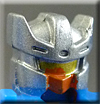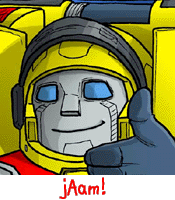
General Information:
Release Date: January 2013
Price Point: $10.99 (depending on retailer)
Retailer: General (Toys R Us, Target, Wal-Mart etc.)
Accessories: Disc Cases x 2
*Images above with asterisks and text below in italics are from the Toys R Us Web Site:
Eject honestly believes that if the Autobots and the Decepticons could just agree to resolve their disputes through some friendly competition, then the entire war could be brought to an end. Ramhorn disagrees. He’d rather spike a Decepticon on his horn than spike a ball in the end zone.
Pop into some "explosive" Transformers action with these special Eject and Ramhorn figures! These Autobot warriors lie in wait in sneaky data disc mode until an unsuspecting Decepticon comes by. With the push of a button, these Eject and Ramhorn figures come flying out in robot mode! Will the Decepticons be able to handle your lightning-quick Eject and Ramhorn figures? Only you can decide!
Pack includes 2 figures and 2 data discs. Series 01 003 Eject & Ramhorn. Ages 5 and up.
When the theatrical animated "Transformers: The Movie" film was released, fans were treated to an epic battle between Autobots and Decepticons at Autobot City on Earth. When the time came for Soundwave's cassette forces to attack the communications center run by Autobot Blaster, fans everywhere were delighted by the sudden introduction of the "Autobot cassettes" who had previously been unseen in animated form. Like the Decepticon cassettes this team was comprised of robots that became both robots and animals. Like their Decepticon counterparts they were released in pairs on cards. One of these pairs was Eject (a robot) with Ramhorn (a rhinocerous).
Now over two decades after their initial introduction, the Autobot cassettes have been reborn in a new form as "Data Discs". In data disc form these new incarnations of the former "cassettes" now interact with the Autobot Blaster figure emulating the Generation One play pattern between G1 Blaster and his cassette team. Once again Eject and Ramhorn have been paired up as Legion Class figures in the "Generations" line.
 In Generation One, the Autobot cassettes who became humanoid robots were new sculpts, separate from Rumble and Frenzy. However, in this new era, they use the same base design as the Rumble with some parts modified. Check out the Frenzy and Rumble reviews to get my first impressions of this sculpt. This part of the review will focus on the changes made to the figure for this release (of which there are many).
In Generation One, the Autobot cassettes who became humanoid robots were new sculpts, separate from Rumble and Frenzy. However, in this new era, they use the same base design as the Rumble with some parts modified. Check out the Frenzy and Rumble reviews to get my first impressions of this sculpt. This part of the review will focus on the changes made to the figure for this release (of which there are many).
Robot Mode:
At first glance it would be easy to dismiss Eject as a simple redeco of the Rumble/Frenzy sculpt, but due to the limited number of parts used to create this figure, any parts swap outs wind up being quite significant. Here's a rundown of what's been changed:
- The panel that forms the head/torso section is a completely new piece. The result is a new head based on the design of the G1 head complete with visor eyes and a mouthplate. The chest all the way down to the waist has a different design than the Rumble/Frenzy sculpt including "wing" like designs on his chest and a series of horizontal (slightly angled) lines on his mid-section.
- The arms have been replaced with new pieces. The most significant design variance is on the forearms, which have a different pattern from the Rumble/Frenzy sculpt.
- The legs (but not the feet) have been replaced with new pieces that have a shorter, raised line design in the center leading to a layered line design that looks like several armor panels overlapping.
In essence this is mostly a new figure. Only the smaller joint pieces and the feet remain the same as Rumble or Frenzy's. I have to say I'm quite impressed by this. I had expected Hasbro to just swap out paint applications in an effort to make the Rumble/Frenzy sculpt to look more like Eject, but this is really a great retooling of an existing figure and a nice homage to the G1 character's designs.
Eject is cast in a light blue and silver plastic. The blue makes up the arms, torso panel and lower legs. Silver makes up the rest. His primary paint color is gold which you'll fin don his eyes, chest, waist and legs. His helmet is painted silver with orange on the mouthplate. Finally a tampographed Autobot symbol is on the center of his torso. The symbol is red with a white outline. The end result is wonderful color homage to G1 Eject who used all the same colors (albeit some in vacuum metallized form). The only unfortunate detail is the orange on the face overlaps the eyes a bit. Hasbro's factories are more than able to deliver precise paint jobs even on this scale, so I do wonder if this was just my copy with this issue.
Eject has six points of articulation. I confess I'm being very generous with my definition of articulation. His knees bend and his feet move, but the knees are spring loaded so they can't stay in place but he can simulate a "kicking" motion which is unintentionally neat and funny. His hands are sculpted to accomodate 3mm peg weapons such as those included with most Cyberverse figures.
Transformation:
To transform Eject into disc mode, raise his arms up. Push in his feet. Push his arms together, then swing the legs out to the sides. Swing the center section up, twist around the legs and swing them up against the panels formed from the arms.
How well Eject transforms when deployed from Autobot Blaster's chest is largely dependent on how he lands. If he just lands on his side and rolls off, then he pretty much stays in disc form. If you manage to land him on the back of the disc form and get the button on the back pressed, he (mostly) auto-transforms int robot mode. To finish the transform, rotate the arms down and swing the feet out.
Disc Mode:
In his "Data Disc" mode Eject is mostly blue plastic with silver and dark blue paint. The silver serves as a background for a blue "circuit" style pattern on the figure (as well as an Autobot symbol in the center). At first I thought this pattern was new but in fact it's the same pattern used on Frenzy, but upside down and horizontally flipped. I really love the way this pattern can be inverted in so many ways and look different.
 Out of all the Autobot "Data Disc" figures Ramhorn is the only completely original sculpt not involving any redecos or retooling. His robotic rhinocerous form is quite distinctive, so it would have been tough to say, turn Ravage's feline form into a rhino and I'm thankful the designers didn't even try!
Out of all the Autobot "Data Disc" figures Ramhorn is the only completely original sculpt not involving any redecos or retooling. His robotic rhinocerous form is quite distinctive, so it would have been tough to say, turn Ravage's feline form into a rhino and I'm thankful the designers didn't even try!
Beast Mode:
In Generation one, Ramhorn was a cassette tape in his alternate form, so he was very thin even though he was meant to be a bulky animal in beast mode. This version of the character has no such problem. All his parts are relatively thick and bulky when compared to say, Ravage or Steeljaw. His head has a horn sticking up right in the center leading to a central body made up of most of the Data Disc's bulk. His legs are thick in the back and smaller in front. He even has a little tail on the back which winds up looking a bit cute (even if it is somewhat accurate to the real life animal). Other cool details include a vent like structure found on his back, small hooves sculpted into the base of each leg and missile launchers with three tubes each sculpted into each forward leg. These missile launchers in particular are a nice homage to the weapons included with Ramhorn's G1 counterpart. his rear legs have tubes sculpted into them that could be rocket launchers or even smokestacks of some sort (let your imagination decide!). One of my favorite touches is his face, which has a mouth sculpted on the sides set in a grim expression befitting the character.
Ramhorn is cast in red and silver plastic. The red is a bit brighter in color than the brownish color of the Generation One figure. His main paint colors are gold and brown. The gold color is used to color the weaponry on his legs, but also most of the top of the figure which shows off part of the circuitry pattern from his "Data Disc" mode. On the left side of his main body is a tampographed Autobot symbol in red with a white outline. Overall the color scheme is distinctly "Ramhorn" in color and he's instantly identifiable.
Ramhorn really doesn't have any functionality in this mode. His legs can swing forward and back in tandem but that's more of a function of his transformation than actual posability. He has no connection points for weapons, which is a shame but I can see how it may have been hard to find a spot for such points.
Transformation:
Swing the rear legs up. Now swing the front legs down. Push the horn/head section down to lock the entire "Data Disc" into place. Push the tail in. If you manage to "drop" Ramhorn right on his transformation "button" on the bottom of the Data Disc, he transforms perfectly, but more often than not he winds up on his back, which is amusing in its own way. I'm just happy all the parts pop out as they should!
Disc Mode:
In this form Ramhorn mostly shows his red and silver plastic on the back of the disc, where you also get a look at a lot of line and vent-like details. Flip him over and you'll see a brown and gold circuit pattern that appears unique to him. I've compared it to all the Decepticon "Data Discs" and none of them quite match it. In the center of the disc he has an Autobot symbol in gold on a brown background.
Final Thoughts:
Eject and Ramhorn were my first pair of Autobot cassettes (long before I even owned a Blaster figure) so I have a special attachment to them. I love the idea of a rhinocerous robot with a bad temper and Eject's love of sports. It made them distinctive. These new incarnations are fantastic as new versions of the characters and homages all at the same time. The biggest issue I have with the pair are some of the less than precise paint applications on Eject. It includes an original sculpt and the lengths to which the Rumble/Frenzy sculpt was retooled is pure awesome. Recommended.
